1.3 Acting On Selected-Items
When browse or search queries display found messages, various tools are available, depending on the current user’s rights.
You will first have to select one or more items with the checkbox before these will function.

1.3.1 Date Range Drop-down

Only messages in the specified time frame are displayed for selection. The date range can be any of the drop-down options or it can be a custom range as selected through the ‘custom’ calendar button.
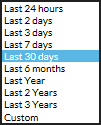
1.3.2 Litigation Hold Icon

After you select the messages you wish to affect, use the Litigation hold icon applies the litigation hold property to messages and items. Items with a litigation hold cannot be removed from the system. To apply or remove the litigation hold from items in the archive, a user must have the litigation hold right.
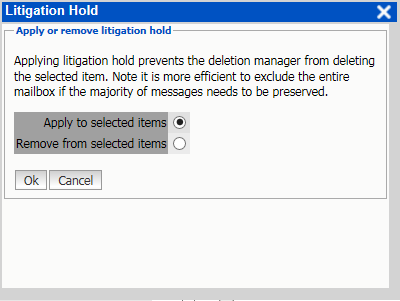
To apply or remove a litigation hold, first select the desired item or items, then click the ‘Litigation Hold’ button to open the litigation hold window.
Select whether to apply or remove the hold. Select ‘Ok’ to continue.
Items which have a hold placed on them display a miniature hold icon next to the message icon.

1.3.3 Confidential State Icon

After you select the messages you wish to affect, use the Confidential State icon to toggle the confidential state.
Confidential items are only visible with Admin rights, or to those specified by the user under the Options | Confidential Exceptions tab. Items which a user has marked in their box as Confidential may be viewed by other users who have the ‘See Confidential Items [other mailboxes]’ admin right.
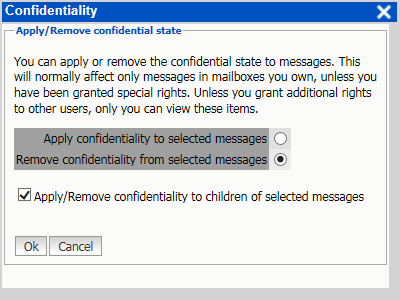
To apply a confidential state to an item, select the item then select the ‘Confidential State’ button.
Items which have been marked confidential display the confidential icon below the message icon.

1.3.4 Tags Icon

After you select the messages you wish to affect, use the Tags icon to add or remove tags from items. This is only visible with appropriate rights. Tags are an informative note which can be attached to any data item in the search messages interface. To apply a tag, select an item and click the ‘Tags’ icon.
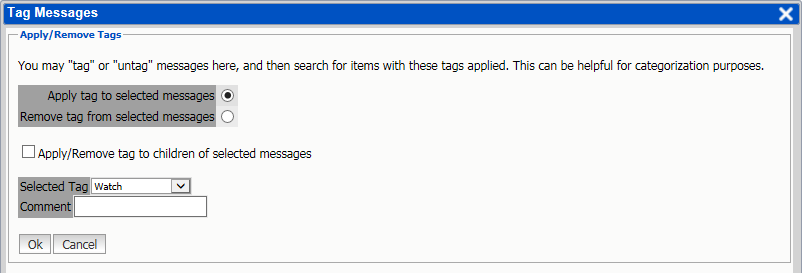
Select the tag which is to be applied. All tags open to use by the user will be displayed. There is no limit to the amount of tags an item may have. An additional comment may be added to the tag for the specific item or items selected. Additionally, any associated items or messages, ‘children’, such as all messages in a thread, may also be selected for tag creation. Tags must be created previous to applying them to messages. See the Tag Definitions tab for more info.
Messages with a tag applied to them, either a global or personal, will show a miniature tag icon next to the message or item icon.
1.3.5 Delete Icon

After you select the messages you wish to affect, use the Delete icon to mark items for removal from personal archives. This right is only visible with rights. To delete an item, highlight the item and then select the ‘Delete’ button.
The Delete right is not a default right, it must be specifically added to users or groups. Messages or data marked to be deleted will not necessarily be immediately removed, but will be queued for deletion. The actual item removal will depend on server availability and the amount of items queued for deletion.
1.3.6 Forward Icon

After you select the messages you wish to affect, use the Forward icon to forward messages out of their archive to a specified address. This right is only visible to users who have the Forward Messages right. The STMP server must be setup by the admin user under Server Configuration | Notification for this to function successfully.
Select a message or messages and then the ‘Forward’ button. Specify the address or comma-separated addresses the messages should be forwarded to, a desired subject, and any comments. Finally, select the ‘Forward Messages’ button and Retain will send the message via SMTP. This is a default user right.
There will also be a notification entered in your Notification Center found under "Welcome, [username]" at the top center of the Retain Mailbox web console.
1.3.7 Export Icon

After you select the messages you wish to affect, use the Export option to export messages, calendar events, and other items in either PST (Microsoft Personal Storage file) or Adobe PDF Portfolio format.
When you click the Export icon, the Export Messages dialog displays, letting you select the output format desired.
For more information, see Exporting Search Results to PST or PDF Files.
1.3.8 Restore Icon

After you select the messages you wish to affect, use the Restore icon to restore messages to the message system. Forwarding is the preferred method to return mail to the email system. To use, select the desired messages and select the ‘restore’ button. Once there, select the target message system and mailbox. (If the user has rights to restore to any mailbox, the target mailbox must be selected. Select the ‘Restore Message’ button and messages will be restored to that account.
Restoring a message which currently exists in the target mailbox results in a duplicate message existing in that mailbox. It is recommended to only restore messages that have been deleted from the mail system, but exist in the Retain archive.
Restore works best with On-Premise Exchange, restoring the message completely to the Exchange Inbox, which is seen as a new message by the system. With GroupWise, it restores a link to the message, if stubbing server is configured in Retain but stubbing does not need to be enabled in GroupWise and we do not recommend enabling Stubbing in GroupWise. Restore does not work with GMail.
1.3.9 Print Icon

After you select the messages you wish to affect, use the Print icon to print selected messages. To use this option, select the desired messages and then select the ‘print’ button. The ‘print’ function utilizes the user’s local print configuration; if there is no printer accessible to the local workstation, print will not function. This is a default user right.
1.3.10 Change Mailbox Icon

If you are an administrator or have proxy rights to another mailbox, use the Change Mailbox option to switch mailboxes.
1.3.11 Quick Search

The Quick Search displays only for Browse tab results. Use it to rapidly search for data in the subject field of messages in the selected mailbox.
1.3.12 Results per page selector

Results are automatically set to 100 per page. The selector lets you specify how many messages are to be displayed on each page. You can use the predefined values or specify an alternative limit in the field provided.
1.3.13 Previous/Next Control

The Previous/Next option lets you navigate through the search or browse result pages. The total number of pages is displayed next to the ‘Next’ button.
Select a number to immediately move to the desired page
1.3.14 Go to Page

The Go To Page option lets you specify what page you want to jump to.
Select the option box, specify the page number desired, and hit ‘enter’ to immediately go to that page.
1.3.15 Quick View

This appears in a column in the list of search results. Click it to quickly view the body of a message without having to actually open the message in the interface.
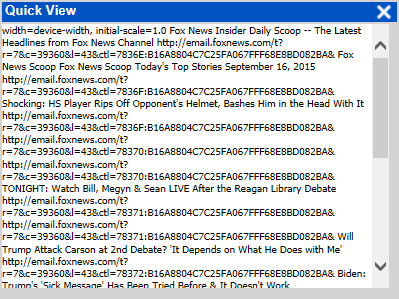
Quick View is a display-only function so there are no actions available. Click the X to close the window.
1.3.16 Selection and Sorting

The top column bar contains all the different column headers and is located directly beneath the toolbar. This tool contains a select all/none checkbox as well as sortable column headers. Every column in this bar may be sorted by order except the ‘Mailbox’ and ‘Folder’ columns. (They are multi-value attributes and thus are not sortable.)
1.3.17 Browse Tab Defaults
By default, the browse window remembers which mailbox last browsed was, and will return to that mailbox when opened. When Administrators first login, they will be taken immediately to their mailbox. Afterwards, the browse will remember their last location.